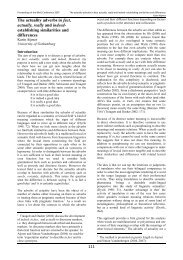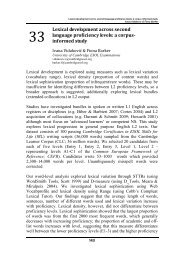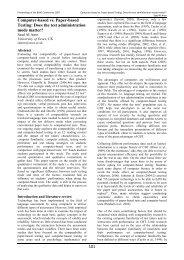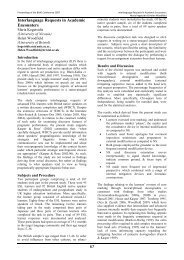Proceedings of the - British Association for Applied Linguistics
Proceedings of the - British Association for Applied Linguistics
Proceedings of the - British Association for Applied Linguistics
Create successful ePaper yourself
Turn your PDF publications into a flip-book with our unique Google optimized e-Paper software.
The Impact <strong>of</strong> <strong>Applied</strong> <strong>Linguistics</strong>: <strong>Proceedings</strong> <strong>of</strong> <strong>the</strong> 44th Annual Meeting <strong>of</strong> BAAL<br />
University <strong>of</strong> <strong>the</strong> West <strong>of</strong> England<br />
diverse developmental pattern seems to be emerging (Muter & Snowling,<br />
1998).<br />
Measure M % SD Max.<br />
Chinese tasks Overall 13.22 66.10 2.40<br />
Rhyme Detection 16.70 83.49 2.17 20<br />
Head Detection 15.25 76.27 2.83 20<br />
Rhyme & Head Detection 12.19 60.95 4.31 20<br />
Rhyme & Head Production 10.30 51.51 4.29 20<br />
Initial Consonant Isolation 11.63 58.17 2.94 20<br />
English tasks Overall 15.04 60.16 4.19<br />
Rhyme Detection 17.97 71.87 3.89 25<br />
Head Detection 17.17 68.70 3.60 25<br />
Rhyme & Head Detection 16.59 66.35 4.99 25<br />
Rhyme & Head Production 10.27 41.08 6.67 25<br />
Initial Consonant Isolation 13.19 52.76 7.47 25<br />
Table 24.1: Descriptive Statistics <strong>for</strong> Phonological Processing Assessments (N = 63)<br />
Fur<strong>the</strong>rmore, <strong>the</strong> result has an implication in relation to EFL learners <strong>of</strong> a<br />
non-alphabetic writing system: Phonological sensitivity might be a general<br />
cognitive mechanism which would develop regardless <strong>of</strong> <strong>the</strong> L1<br />
orthography. In <strong>the</strong> present study, all participants had been taught <strong>the</strong><br />
alphabet and phonics <strong>for</strong> more than one year when <strong>the</strong>se tasks were<br />
administered to <strong>the</strong>m. Although <strong>the</strong>y had received more instruction in<br />
small-unit awareness, i.e., phonics, <strong>the</strong> result shows that <strong>the</strong>y had more<br />
sophisticated large-unit phonological sensitivity. It was likely that largeunit<br />
phonological sensitivity was more <strong>of</strong> a universal skill reflected in <strong>the</strong><br />
phonology <strong>of</strong> all languages and developed regardless <strong>of</strong> whe<strong>the</strong>r an opaque<br />
relationship existed between <strong>the</strong> orthography and <strong>the</strong> phonology <strong>of</strong> a<br />
language (Gottardo et al., 2001).<br />
Cross-Language Transfer <strong>of</strong> Phonological Sensitivity<br />
A series <strong>of</strong> correlation analyses revealed moderate inter-correlations<br />
between corresponding tasks in both languages shown in <strong>the</strong> diagonal line<br />
(see Table 24.2), suggesting that cross-language transfer <strong>of</strong> phonological<br />
processing skills might have occurred.<br />
The fact that <strong>the</strong> participants had better developed Chinese phonological<br />
sensitivity indicates that such sensitivity was more likely to transfer from<br />
<strong>the</strong>ir L1 to L2, ra<strong>the</strong>r than vice versa. The finding is consistent with that <strong>of</strong><br />
previous research on alphabetic language users (Cisero & Royer, 1995;<br />
Comeau et al., 1999) and on learners with a non-alphabetic language<br />
background (Bialystok et al., 2005; Gottardo et al., 2001; Wang et al.,<br />
2003).<br />
120







